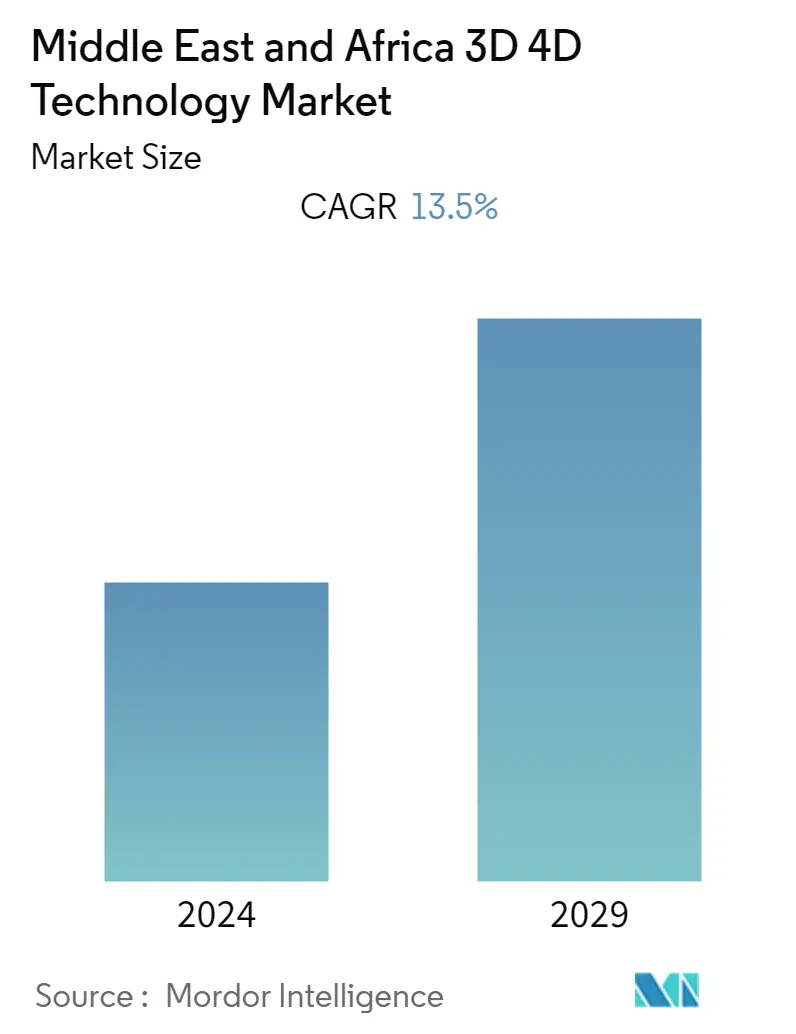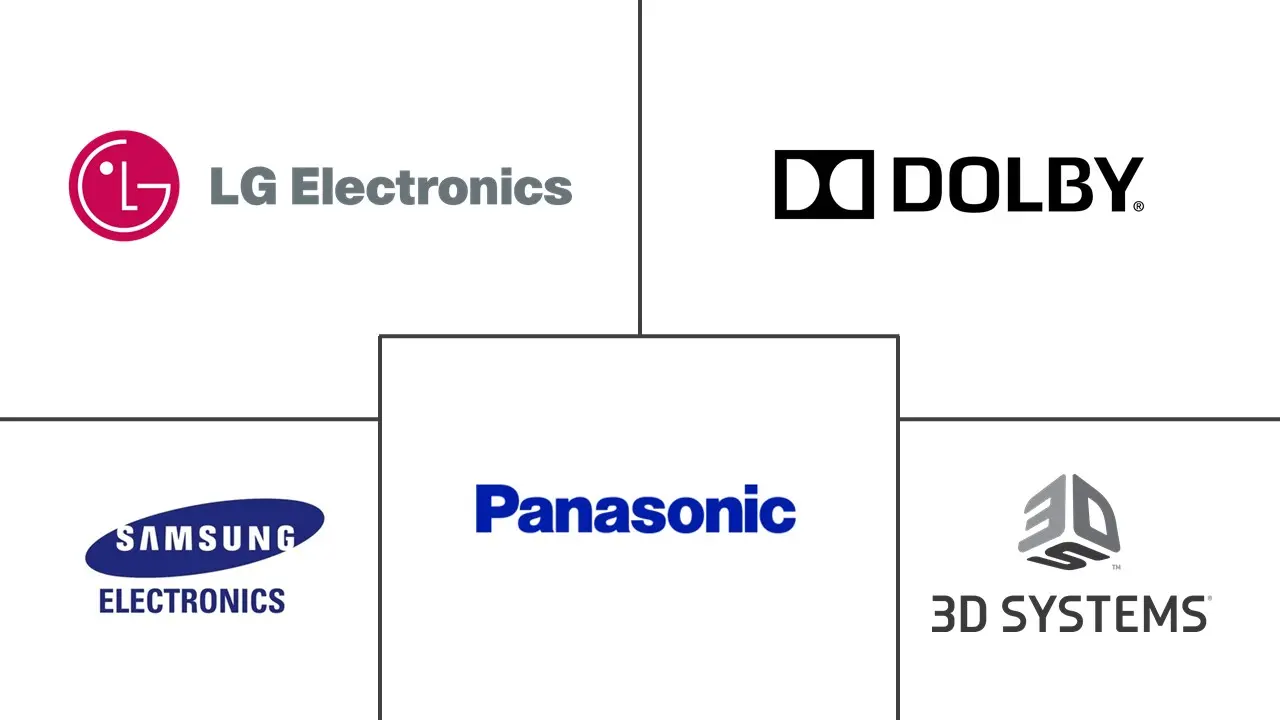Market Size of Middle East and Africa 3D 4D Technology Industry

| Study Period | 2019 - 2029 |
| Base Year For Estimation | 2023 |
| Forecast Data Period | 2024 - 2029 |
| Historical Data Period | 2019 - 2022 |
| CAGR | 13.50 % |
| Market Concentration | Medium |
Major Players
*Disclaimer: Major Players sorted in no particular order |
MEA 3D 4D Technology Market Analysis
The Middle East and Africa 3D 4D Market is expected to reach a CAGR of 13.5% during the forecast period. Currently, 3D printing technology has come in handy for the medical sector. COVID-19 patients need medical devices, such as ventilators, to keep breathing, putting enormous pressure on hospitals that are currently overflowing with demand. Keeping this in mind, several vendors have developed 3D printer ventilators and valves, which would reduce the shortage of machines needed to treat sick patients.
- For the past year, researchers have incorporated the post-processing step in the 4D printing process itself, and the materials used are expanded to shape memory polymers, liquid crystal elastomers, and hydrogels.
- These materials can be used in cases where maintenance is difficult, such as in biomedical engineering, where stents can be manufactured using this technology. Advanced healthcare has the maximum application since printing organs and tissues for the human body using 3D printing is already prevalent; hence, much more can be achieved using 4D printing.
- As 3D printing continues to be paired with robots, whether in making parts for them or in creating robots that can operate 3D printers, the next level in soft robotics can be attained with 4D printing. Soft robotics utilize certain soft materials, such as elastomers, which act as the interaction interface between robots and their environment. These soft materials allow for a gentle interaction with fragile objects and allow for a better tolerance toward damaging forces when compared to traditional robotics.
- The UAE government has also been actively supporting the creation of advanced manufacturing and design hubs. An initiative, known as Dubai 3D Printing Strategy, was recently launched to promote the status of the United Arab Emirates, specifically Dubai, as the leading hub of 3D printing technology by the year 2030.
- The Suzhou building, a five-story apartment complex, is taller; the 31-foot-tall Dubai building is larger by volume at 6,900 square feet. Its purpose is a bit less exciting than its construction; it will be used for administrative work by the Dubai Municipality. Also, according to the Dubai Future Foundation, Dubai plans to 3D print 25% of every new building by 2025. Among the many sectors, the initial focus is on the construction sector. This exhibits the growth of 3D reconstruction in the coming future.
MEA 3D 4D Technology Industry Segmentation
Some of the prominent countries in the region are rapidly adopting 3D 4D technologies in various end-user industries, which are expected to drive the market during the forecast period. The Middle East and Africa 3D 4D Technology Market are Segmented By Application (Electrical & Electronic Components (IC, Transistors, Sensors Etc), 3D Printer, 3D Gaming Console, 3D Imaging, 3D Displays), By End-User (Healthcare, Entertainment & Media, Education, Government, Industrial, Consumer Electronics), and Country.
| Application | |
| Electrical & Electronic Components (IC, Transistors, Sensors Etc) | |
| 3D Printer | |
| 3D Gaming Console | |
| 3D Imaging | |
| 3D Displays | |
| Other Applications |
| End-User | |
| Healthcare | |
| Entertainment & Media | |
| Education | |
| Government | |
| Industrial | |
| Consumer Electronics |
| Country | |
| United Arab Emirates | |
| Saudi Arabia | |
| South Africa | |
| Rest of Middle East and Africa |
Middle East and Africa 3D 4D Technology Market Size Summary
The Middle East and Africa 3D 4D Technology Market is experiencing significant growth, driven by advancements in 3D and 4D printing technologies across various sectors, particularly healthcare and construction. The medical sector has seen substantial benefits from 3D printing, with applications ranging from the production of medical devices like ventilators during the COVID-19 pandemic to the development of patient-specific anatomical models for surgical planning. The integration of 4D printing, which involves materials such as shape memory polymers and hydrogels, is further enhancing capabilities in biomedical engineering, allowing for the creation of stents and other medical devices that require minimal maintenance. The UAE, in particular, is positioning itself as a leader in this field through initiatives like the Dubai 3D Printing Strategy, which aims to make Dubai a global hub for 3D printing technology by 2030.
The market is characterized by a moderate level of fragmentation, with both international and new players contributing to its competitive landscape. The construction sector is a key area of focus, with projects like the 3D-printed buildings in Dubai showcasing the potential of these technologies. Companies are investing in innovative healthcare solutions, such as AI-based 3D reconstruction technologies, to improve surgical outcomes and reduce costs. Collaborative efforts, such as those by Immensa Technology and global players like Sandvik, are strengthening the region's position in additive manufacturing. The market's growth is further supported by government initiatives and strategic partnerships, which are fostering the adoption of 3D and 4D technologies across various industries.
Middle East and Africa 3D 4D Technology Market Size - Table of Contents
-
1. MARKET DYNAMICS
-
1.1 Market Overview
-
1.2 Industry Value Chain Analysis
-
1.3 Industry Attractiveness - Porter's Five Forces Analysis
-
1.3.1 Bargaining Power of Consumers
-
1.3.2 Bargaining Power of Suppliers
-
1.3.3 Threat of New Entrants
-
1.3.4 Threat of Substitute Products
-
1.3.5 Intensity of Competitive Rivalry
-
-
1.4 Technology Snapshot
-
1.4.1 Trends in 3D Technology
-
1.4.2 Trends in 4D Technology
-
1.4.3 Applications of 3D/4D Technology
-
-
1.5 Market Drivers
-
1.5.1 Increasing Applications of 3D Printing in Construction
-
1.5.2 Increased investment in R&D expected to boost market growth
-
-
1.6 Market Restraints
-
1.6.1 Costs and availability of Raw Material
-
1.6.2 Economic Instability of The Region
-
-
1.7 Market Opportunities
-
1.7.1 Increasing usage of 3D Technology in Healthcare
-
-
-
2. MARKET SEGMENTATION
-
2.1 Application
-
2.1.1 Electrical & Electronic Components (IC, Transistors, Sensors Etc)
-
2.1.2 3D Printer
-
2.1.3 3D Gaming Console
-
2.1.4 3D Imaging
-
2.1.5 3D Displays
-
2.1.6 Other Applications
-
-
2.2 End-User
-
2.2.1 Healthcare
-
2.2.2 Entertainment & Media
-
2.2.3 Education
-
2.2.4 Government
-
2.2.5 Industrial
-
2.2.6 Consumer Electronics
-
-
2.3 Country
-
2.3.1 United Arab Emirates
-
2.3.2 Saudi Arabia
-
2.3.3 South Africa
-
2.3.4 Rest of Middle East and Africa
-
-
Middle East and Africa 3D 4D Technology Market Size FAQs
What is the current Middle East and Africa 3D 4D Technology Market size?
The Middle East and Africa 3D 4D Technology Market is projected to register a CAGR of 13.5% during the forecast period (2025-2030)
Who are the key players in Middle East and Africa 3D 4D Technology Market?
3D Systems Corporation, Dolby Laboratories, Inc., LG Electronics Inc., Samsung Electronics Co., Ltd. and Panasonic Corporation are the major companies operating in the Middle East and Africa 3D 4D Technology Market.

